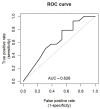Machine Learning Prediction of Tongue Pressure in Elderly Patients with Head and Neck Tumor: A Cross-Sectional Study
- PMID: 38673635
- PMCID: PMC11051183
- DOI: 10.3390/jcm13082363
Machine Learning Prediction of Tongue Pressure in Elderly Patients with Head and Neck Tumor: A Cross-Sectional Study
Abstract
Background: This investigation sought to cross validate the predictors of tongue pressure recovery in elderly patients' post-treatment for head and neck tumors, leveraging advanced machine learning techniques. Methods: By employing logistic regression, support vector regression, random forest, and extreme gradient boosting, the study analyzed an array of variables including patient demographics, surgery types, dental health status, and age, drawn from comprehensive medical records and direct tongue pressure assessments. Results: Among the models, logistic regression emerged as the most effective, demonstrating an accuracy of 0.630 [95% confidence interval (CI): 0.370-0.778], F1 score of 0.688 [95% confidence interval (CI): 0.435-0.853], precision of 0.611 [95% confidence interval (CI): 0.313-0.801], recall of 0.786 [95% confidence interval (CI): 0.413-0.938] and an area under the receiver operating characteristic curve of 0.626 [95% confidence interval (CI): 0.409-0.806]. This model distinctly highlighted the significance of glossectomy (p = 0.039), the presence of functional teeth (p = 0.043), and the patient's age (p = 0.044) as pivotal factors influencing tongue pressure, setting the threshold for statistical significance at p < 0.05. Conclusions: The analysis underscored the critical role of glossectomy, the presence of functional natural teeth, and age as determinants of tongue pressure in logistics regression, with the presence of natural teeth and the tumor site located in the tongue consistently emerging as the key predictors across all computational models employed in this study.
Keywords: XGBoost; head and neck tumor; logistic regression; machine learning; oral function; random forest; support vector machine; tongue pressure.
Conflict of interest statement
The authors declare no conflicts of interest.
Figures
Similar articles
-
Can Predictive Modeling Tools Identify Patients at High Risk of Prolonged Opioid Use After ACL Reconstruction?Clin Orthop Relat Res. 2020 Jul;478(7):0-1618. doi: 10.1097/CORR.0000000000001251. Clin Orthop Relat Res. 2020. PMID: 32282466 Free PMC article.
-
Comparison and development of machine learning for thalidomide-induced peripheral neuropathy prediction of refractory Crohn's disease in Chinese population.World J Gastroenterol. 2023 Jun 28;29(24):3855-3870. doi: 10.3748/wjg.v29.i24.3855. World J Gastroenterol. 2023. PMID: 37426324 Free PMC article.
-
Predicting maximum occlusal force and tongue pressure using decision tree analysis in patients diagnosed with head and neck tumors.J Prosthet Dent. 2024 Apr 24:S0022-3913(24)00217-8. doi: 10.1016/j.prosdent.2024.03.025. Online ahead of print. J Prosthet Dent. 2024. PMID: 38664182
-
Prediction Model of Osteonecrosis of the Femoral Head After Femoral Neck Fracture: Machine Learning-Based Development and Validation Study.JMIR Med Inform. 2021 Nov 19;9(11):e30079. doi: 10.2196/30079. JMIR Med Inform. 2021. PMID: 34806984 Free PMC article.
-
Interpretable machine learning model to predict surgical difficulty in laparoscopic resection for rectal cancer.Front Oncol. 2024 Feb 6;14:1337219. doi: 10.3389/fonc.2024.1337219. eCollection 2024. Front Oncol. 2024. PMID: 38380369 Free PMC article. Review.
References
Grants and funding
LinkOut - more resources
Full Text Sources



